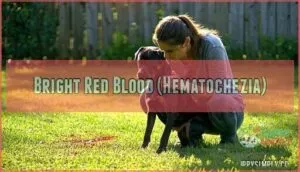This site is supported by our readers. We may earn a commission, at no cost to you, if you purchase through links.

The appearance of the blood matters. Bright red streaks suggest lower intestinal issues, while dark, tarry stool indicates bleeding higher up in the digestive tract.
Your dog’s overall condition tells the real story. A dog who’s eating, playing, and acting normal requires monitoring and a vet visit soon. But lethargy, repeated vomiting, pale gums, or abdominal pain means you’re facing an emergency that demands immediate attention.
Table Of Contents
- Key Takeaways
- Why is My Dog Pooping Blood?
- What Does Blood in Dog Poop Look Like?
- What Symptoms Should I Watch For?
- When is Blood in Stool an Emergency?
- What Causes Bloody Stool in Dogs?
- How Do Vets Diagnose Bloody Stool?
- What Treatment Options Are Available?
- How Can I Support My Dog at Home?
- How Can Bloody Stools Be Prevented?
- Will My Dog Recover From Bloody Stool?
- Frequently Asked Questions (FAQs)
- What is the difference between hematochezia and melena in dogs?
- What should I do if my dog has been vomiting and has bloody stool?
- Can stress or anxiety cause bloody stool?
- Is bloody stool contagious to other pets?
- What foods should I avoid completely?
- How much does diagnosis and treatment cost?
- Can puppies have different causes than adults?
- Conclusion
Key Takeaways
- Bloody stool in dogs ranges from minor dietary issues to life-threatening emergencies—bright red blood suggests lower intestinal problems, while dark, tarry stool indicates upper GI bleeding that requires immediate attention.
- Your dog’s overall behavior matters more than the blood itself: a lethargic dog with pale gums, vomiting, or abdominal pain needs emergency care, while an active dog eating normally can be monitored with a vet visit scheduled soon.
- Common causes include parasites, infections, dietary indiscretion, inflammatory bowel disease, and cancer—but up to 70% of mild cases lasting under 48 hours resolve with basic dietary changes and watchful waiting.
- Early veterinary intervention dramatically improves outcomes, with treatment within 24-48 hours showing a significantly better prognosis than delayed care, especially for serious conditions like hemorrhagic gastroenteritis or internal bleeding.
Why is My Dog Pooping Blood?
Seeing blood in your dog’s stool can feel alarming, but understanding what’s behind it helps you respond quickly and confidently. The causes range from minor dietary hiccups to conditions that need immediate veterinary attention.
Let’s look at the common triggers, how to tell if it’s serious, and what steps to take next.
Common Causes of Bloody Stool
From dietary mishaps to serious disease, bloody stool in dogs stems from various sources. Infections like bacteria or viruses can inflame the gut. Parasites such as intestinal worms disrupt digestion. Dietary indiscretion—eating garbage or spoiled food—triggers gastroenteritis. Cancer or tumors in the digestive tract cause bleeding. Inflammatory bowel disease (IBD) produces chronic issues, while acute hemorrhagic diarrhea syndrome strikes suddenly. Hemorrhagic gastroenteritis can cause severe bloody diarrhea.
Common causes of bloody stool in dogs include:
- Infections from bacteria, viruses, or gastroenteritis
- Parasites like intestinal worms or giardia
- Dietary indiscretion (eating non-food items or spoiled food)
- Cancer, tumors, or masses in the digestive tract
- Inflammatory bowel disease (IBD) or chronic inflammation
Serious Vs. Minor Conditions
Not all bloody stool signals emergency care. Mild dietary indiscretion accounts for up to 70% of cases lasting under 48 hours—small streaks on normal stool, no other symptoms. Your dog stays active, eats well, and bounces back quickly.
But serious symptoms tell a different story. Repeated bloody diarrhea, vomiting, lethargy, or pale gums point to conditions like hemorrhagic gastroenteritis or internal bleeding. Black, tarry stool signals upper GI bleeding. Puppies and seniors face higher risks.
Systemic signs appear in 60–90% of emergency cases, sometimes progressing to hypovolemic shock. Blood volume and symptom duration separate watchful waiting from urgent action. If bloody stool is paired with low energy, it requires immediate veterinary attention.
How to Assess Severity
Start by checking how fast things are changing—if your dog’s bright and playful with a single episode, you’ve got time to watch; if they’re refusing food or showing new symptoms by the hour, you need a vet now.
Look at blood amount and stool consistency together. Check gum color—pale or white signals emergency care. Monitor hydration status by gently pulling skin; slow return means trouble.
Combining key signs with symptom patterns separates serious symptoms from passing issues.
What Does Blood in Dog Poop Look Like?
Blood in your dog’s stool can show up in different ways, and knowing what you’re looking at helps you describe it to your vet. The appearance tells us where the bleeding is happening in the digestive system.
Here are the main types you might see.
Bright Red Blood (Hematochezia)
When you spot bright red blood in your dog’s stool, you’re looking at fresh bleeding from the lower part of the digestive tract. This bright color means the blood hasn’t been digested. Common sources include the colon, rectum, or anal area.
You might see streaks of blood coating the stool or drops after your dog finishes. A rectal exam helps your vet pinpoint where the bleeding starts.
Black or Tarry Stool (Melena)
If your dog’s stool looks dark, almost black, and has a sticky, tar-like texture, that’s melena—a sign that bleeding is happening higher up in the digestive system. Blood from the stomach or upper GI tract gets digested on its way through, turning it dark.
- Melena causes include stomach ulcers, kidney or liver disease, and ingestion of toxins
- Internal bleeding in the gastrointestinal tract requires immediate veterinary diagnosis and treatment
- Melena prognosis depends on catching the underlying condition early—delay can be life-threatening
Mucus and Other Abnormalities
Beyond bright red streaks or tarry darkness, you might also notice a slippery coating of mucus in your dog’s stool—or other unusual changes that signal something’s off in the gut. Excess mucus often points to colitis or irritation in the lower intestines.
Watch for stool consistency shifts, color changes, undigested food, or even foreign objects. If you’re unsure, collect a stool sample for dog poop analysis at your vet.
What Symptoms Should I Watch For?
Blood in your dog’s stool rarely shows up alone. Other warning signs can help you figure out what’s wrong and how quickly you need to act. Here’s what to keep an eye on.
Vomiting and Loss of Appetite
A dog who’s vomiting or turning away from their food bowl is often telling you that something’s gone seriously wrong in their gut. When paired with bloody stool, these symptoms signal your dog’s body is struggling to process food. Dehydration risks climb fast when vomiting continues. Watch for these warning signs:
- Nausea signs like excessive drooling or lip licking
- Food aversion lasting more than 12 hours
- Multiple vomiting episodes in one day
- Inability to keep water down
- Weak attempts to eat followed by turning away
Lethargy and Weakness
When your dog moves like they’re stuck in slow motion—barely lifting their head or struggling to stand—their body is waving a red flag that shouldn’t be ignored. Lethargy and weakness are symptoms of dog pooping blood that signal serious trouble. Blood loss drains energy fast, leaving dogs too tired to greet you or play.
Watch for identifying lethargy signs: refusing walks, collapsing after standing, or sleeping constantly. Track symptom progression carefully.
The impact of weakness combined with bloody stool creates dog health emergencies requiring immediate help. Seek veterinary care when these causes overlap with bloody diarrhea.
Abdominal Pain or Swelling
Your dog’s belly tells a story—and when it’s tight, tender, or bloated alongside bloody stool, that story demands urgent attention. Abdominal pain shows up as hunching, whimpering when touched, or refusing to let you near their stomach.
Swelling severity matters—mild distension signs differ from rock-hard bloating causes like internal bleeding or gastrointestinal issues. Palpation findings help vets pinpoint pain location and detect internal injuries requiring emergency intervention.
Diarrhea and Frequency Changes
Diarrhea and sudden urgency changes signal your dog’s digestive tract is struggling. Watch for shifts in stool consistency—especially if chronic diarrhea or bloody diarrhea replaces firm dog stool.
Frequent trips outside mean dehydration risk climbs fast. Track frequency patterns and note any blood in stool. If normal dog poop turns loose or red, call your vet before things worsen.
When is Blood in Stool an Emergency?
Not all bloody stool requires a midnight dash to the emergency vet, but some situations can’t wait until morning. Certain warning signs indicate your dog’s condition is critical and needs immediate attention.
Here’s what separates a genuine emergency from something that can be monitored at home.
Signs of Shock or Severe Illness
Shock can develop quickly when bloody stool stems from severe blood loss or systemic illness. Dogs in this critical state need emergency care immediately. Watch for pale gums, which signal poor blood flow, along with rapid or weak pulse quality. You might notice cold extremities, low body temperature, and altered mental state—your dog may seem dazed or unresponsive. Changes in breathing rate, sudden collapse, and profound weakness are red flags you can’t ignore.
- Gum changes: Pale, gray, or white gums with slow capillary refill
- Cardiovascular signs: Weak pulse quality, cold ears and paws, body temp below 99°F
- Neurologic symptoms: Confusion, unresponsiveness, collapse, or weaving movements
Persistent or Worsening Symptoms
Even symptoms that seem stable at first can gradually deteriorate, revealing a problem that’s getting worse under the surface. Recurring blood in stool signals unresponsive treatment or a condition gaining ground.
Increased lethargy paired with new symptoms—like intensifying abdominal pain or rapid decline in appetite—demands emergency veterinary care.
When your dog’s illness diagnosis remains unclear or symptoms escalate despite initial care, don’t wait for a crisis.
When to Seek Immediate Veterinary Care
Some warning signs don’t ask for permission—they demand action right now. Pale gums, collapse, or extreme weakness mean your dog needs emergency veterinary care immediately.
Uncontrollable vomiting paired with bloody stool, or severe lethargy where your dog can’t stand, are symptoms of dog illness that require an emergency vet without delay.
What Causes Bloody Stool in Dogs?
Bloody stool doesn’t happen out of nowhere. Your dog’s body is signaling that something’s wrong in the digestive system.
Let’s walk through the main culprits so you know what might be happening.
Infections and Parasites
Infections top the list when bloody stool appears. Parvovirus prevalence reaches 44% in puppies under six months, with bloody diarrhea showing up in over 60% of infected dogs. Bacterial infections like Clostridioides difficile and protozoal causes, including Giardia and Cryptosporidium, strike hard, especially in shared spaces like dog parks where zoonotic risks climb. Parasite seasonality matters—hookworms peak in late summer, while roundworms surge in winter.
Watch for these infectious culprits:
- Viral infections like parvovirus type 2b causing severe hemorrhagic diarrhea even in vaccinated adults
- Parasitic infections from hookworms, whipworms, and roundworms leading to gastrointestinal bleeding and anemia
- Bacterial infections such as Salmonella and Campylobacter triggering hemorrhagic gastroenteritis
- Protozoal parasites like Giardia surviving months in contaminated environments and water sources
- Heavy infestations remaining asymptomatic until sudden acute or chronic bloody diarrhea appears
Dietary Indiscretion and Toxins
Dogs eat first and think later—a habit that turns dangerous when they gulp down spoiled food, garbage, or toxic substances that irritate their digestive tract enough to cause bleeding. Dietary indiscretion causes "garbage gut," while rodenticide poisoning prevents blood clotting. Foreign objects like bones or toys scrape intestinal walls. Toxin ingestion from household poisons triggers immediate bleeding.
Food sensitivities also inflame the gut lining, though less severely than direct poisoning.
Cancer, Tumors, and Chronic Diseases
Malignant tumors in your dog’s digestive tract bleed as they invade surrounding tissue, causing cancer-related melena or bright red blood depending on location. Over 60% of canine tumors are malignant, with colorectal adenocarcinomas most common in middle-aged dogs.
Chronic GI disease, including inflammatory bowel disease and pancreatitis, also produces persistent chronic diarrhea and weight loss.
Certain breed predispositions exist—French Bulldogs and Yorkshire Terriers face higher colorectal cancer risk.
Late-stage tumor metastasis may require end-of-life discussions with your vet.
Food Allergies and Inflammatory Conditions
Your dog’s immune system can mistake certain proteins in food for threats, triggering inflammation that damages the gut lining and causes bloody stool. Food sensitivities often mimic inflammatory bowel disease, producing mucousy diarrhea and colitis. Common culprits include beef, dairy, and chicken.
Your vet may recommend allergy testing or a dietary elimination trial—removing suspected ingredients for 8-12 weeks to identify the problem protein causing gut inflammation and IBD symptoms.
How Do Vets Diagnose Bloody Stool?
When your dog shows up with blood in their stool, your vet won’t just guess at the cause. They’ll run a series of tests to pinpoint what’s going on inside your dog’s digestive system.
Here’s what you can expect during the diagnostic process.
Physical and Rectal Examination
When your vet examines your dog for bloody stool, they’ll start with a thorough hands-on assessment that includes checking your dog’s overall condition and performing a rectal exam to feel for abnormalities, blockages, or signs of bleeding.
Here’s what your veterinarian will assess:
- Abdominal palpation to detect pain, swelling, or masses that might explain the bleeding
- Digital examination of the rectum to check for polyps, tumors, or anal gland problems
- Mucus membranes and hydration status to evaluate blood loss severity and overall health
Stool, Blood, and Imaging Tests
After the physical exam wraps up, your vet will likely run a series of lab tests and imaging studies to pinpoint exactly what’s causing the bleeding and how serious the situation is.
A stool sample checks for parasites, abnormal bacteria, and fecal blood through detailed fecal analysis. Blood panels reveal anemia, organ function, and infection markers.
Radiographs and ultrasound use help detect tumors, blockages, or internal damage that explain the symptoms.
Endoscopy and Biopsy
If standard tests don’t reveal the problem, your vet may recommend endoscopy or colonoscopy to get a direct look inside your dog’s digestive tract and collect tissue samples for biopsy.
These diagnostic procedures use a flexible scope to visualize the intestinal lining and identify inflammation, ulcers, or tumors that radiographs and fecal exams might miss.
Biopsy analysis provides definitive answers about cancer or inflammatory bowel disease, though the procedure requires anesthesia and carries minimal complication risks.
What Treatment Options Are Available?
Once your vet identifies the cause, treatment can begin right away. The approach depends on what’s behind the bleeding and how sick your dog is.
Here’s what most treatment plans involve.
Medications and Fluid Therapy
Treatment often begins with medications specific to your dog’s diagnosis and fluid therapy to combat dehydration. Common medications include:
- Antiemetic drugs to control vomiting and nausea
- Antibiotic use to fight bacterial infections causing inflammation
- Ulcer treatments like antacids to protect the digestive lining
Fluid therapy corrects electrolyte balance and replaces fluid loss. Anti-inflammatory drugs or immunosuppressants may be added depending on the underlying condition.
Dietary Changes and Supportive Care
Along with medications and fluids, your dog’s digestive system needs time to heal — and that starts with what goes into the bowl. Dietary changes play a central role in recovery. A bland diet of boiled chicken and rice is often the first step, giving the gut a break from complex proteins. Hydration strategies, like adding broth to meals, encourage fluid intake. Probiotic benefits include restoring healthy gut bacteria, while fiber supplementation can firm up loose stool. If a food allergy or intolerance is suspected, your vet may recommend a modified or hypoallergenic diet to identify triggers and reduce inflammation.
| Dietary Approach | Purpose | Examples |
|---|---|---|
| Bland Diet | Rest the digestive tract | Boiled chicken, white rice, plain pumpkin |
| Hypoallergenic Diet | Identify food allergies | Novel protein sources, hydrolyzed proteins |
| Probiotic Supplementation | Restore gut flora | Veterinary probiotics, fermented foods |
| Fiber Addition | Firm stool consistency | Canned pumpkin, psyllium husk |
| Hydration Boosters | Prevent dehydration | Low-sodium broth, water-soaked kibble |
Treating Underlying Health Issues
Sometimes dietary support alone isn’t enough — the real fix depends on what’s driving the problem in the first place. Kidney disease, liver disease, pancreatitis, colitis, and Addison’s disease each require specific treatment plans. Your vet may prescribe anti-inflammatory drugs, antibiotics, or medications specific to the condition.
A modified diet often aids long-term management. Veterinary care assures the treatment options match your dog’s diagnosis.
How Can I Support My Dog at Home?
Once your vet has started treatment, your job shifts to keeping a close watch and creating the right conditions for healing. You can’t fix the underlying cause yourself, but you can make recovery easier and spot warning signs early.
Here’s what matters most at home.
Monitoring Vital Signs and Symptoms
Keeping a close eye on your dog’s condition at home helps you catch warning signs before they turn into bigger problems. Check your dog’s gum color several times daily—pale gums signal blood loss. Monitor their breathing rate and heart rate if possible.
Watch for fever, dehydration, increased weakness, or signs of pain. Document any changes in symptoms so you can report them accurately to your vet.
Providing a Gentle Diet
Your vet will likely recommend a bland, easily digestible diet to give your dog’s gut a chance to heal and settle down. Think boiled chicken and plain rice or pumpkin—simple bland food options that are easy on inflamed intestines.
Start with small portions, then use gradual food introduction to return to their regular diet.
If food allergies are suspected, your vet might suggest a hypoallergenic diet or food allergy trials to pinpoint triggers.
Reducing Stress and Promoting Recovery
Stress can slow healing just as much as any infection, so creating a calm, comfortable space matters more than you might think. Environmental changes and anxiety put extra strain on the body.
Keep these supportive actions in mind during recovery:
- Create a quiet environment away from household noise and activity
- Offer gentle exercise like short leashed walks, avoiding strenuous play
- Provide mental stimulation through puzzle toys or calm interaction
- Use dietary support your vet recommends, including probiotics benefits for gut health
- Schedule a veterinary consultation if stress levels remain high
A stress-free environment gives your dog the best shot at bouncing back.
How Can Bloody Stools Be Prevented?
While you can’t prevent every case of bloody stool, you can take steps to reduce your dog’s risk. Simple habits like routine vet visits, managing their diet, and keeping their environment safe go a long way.
Here’s what works best to keep your dog’s digestive system healthy.
Regular Vet Check-Ups
Routine wellness visits aren’t just for vaccines—they’re your best shot at catching problems before blood shows up in the stool. Your veterinarian can spot early signs of disease during wellness exams, making preventative care a cornerstone of dog health and wellness. Parasite control, vaccination importance, and early detection all happen during these checkups.
| Preventive Measure | Frequency | Benefit |
|---|---|---|
| Wellness exams | Every 6–12 months | Catches disease early |
| Fecal screening | Annually or as needed | Identifies parasites |
| Bloodwork | Yearly for seniors | Monitors organ function |
| Vaccinations | Per veterinary schedule | Prevents infections |
| Deworming | As recommended | Controls intestinal parasites |
Regular veterinary care gives you peace of mind and keeps your dog one step ahead of serious health issues.
Safe Diet and Environment
What your dog eats and where they roam can be the difference between a healthy gut and a trip to the emergency vet. Keep toxic substances locked away and feed a balanced diet suited to your dog’s needs. Dietary changes should happen gradually to avoid stress on the gut.
Provide safe exercise and mental stimulation in a stress-free environment. Monitor stool quality daily—it’s your early warning system for trouble ahead.
Parasite Prevention and Hygiene
Parasites don’t knock before entering—they hitch a ride on contaminated soil, water, or infected animals, making prevention your dog’s best defense. Fecal exams and deworming schedules catch intestinal worms like hookworms and whipworms before they wreak havoc.
Pick up stool promptly and sanitize your yard to break the parasite lifecycle.
Preventative medications and hygiene practices—like washing food bowls and avoiding contaminated areas—keep dog parasite infections at bay.
Will My Dog Recover From Bloody Stool?
Most dogs recover well from bloody stool when the cause is caught and treated early. Your dog’s outcome depends on what’s causing the bleeding, how quickly you act, and whether ongoing care is needed.
Let’s look at what influences recovery and what you can expect moving forward.
Factors Affecting Prognosis
Recovery chances hinge on several key factors that work together to shape your dog’s outcome. Treatment timeliness plays a critical role—dogs treated within 24-48 hours show considerably better prognosis than those who wait longer.
Here’s what influences severity and overall health outcomes:
- Underlying cause: Parasites resolve quickly with medication, while tumors carry poorer long-term outcomes
- Age factors: Puppies under 12 months with incomplete vaccinations face longer recovery times
- Complications present: Fever, vomiting, or dehydration lower survival rates and extend hospitalization
- Treatment response: Dogs needing plasma therapy generally have more severe illness
- Recurrence risk: Incomplete parasite treatment or chronic inflammatory conditions may return
Importance of Early Intervention
Acting fast can mean the difference between a simple fix and a life-threatening crisis. Faster diagnosis leads to improved outcomes and reduced complications that can spiral out of control.
Early veterinary consultation catches treatable conditions before they become emergencies, saving you emergency care costs while enhancing your dog’s comfort.
When symptoms appear, don’t wait—your veterinarian can quickly identify what’s causing the bleeding and start treatment before serious damage occurs.
Long-Term Management and Follow-Up
Once the immediate crisis passes, many dogs need ongoing care to keep the problem from coming back. Your veterinary consultation will establish a management plan that may include dietary changes, anti-inflammatory drugs, or medication adjustments. Follow your vet’s schedule closely and monitor for relapse.
A stress-free environment promotes quality of life, and some chronic conditions require palliative care. Dietary maintenance prevents future episodes—stay consistent with what works for your dog.
Frequently Asked Questions (FAQs)
What is the difference between hematochezia and melena in dogs?
Nearly 80% of GI bleeding cases show distinct blood color patterns. Hematochezia appears as bright red blood, indicating lower GI tract bleeding, while melena presents as dark, tarry stool from upper digestive tract issues requiring different diagnostic approaches.
What should I do if my dog has been vomiting and has bloody stool?
Call your veterinarian or an emergency clinic immediately. Vomiting combined with bloody stool signals serious dehydration risk and potential internal bleeding. Don’t offer food or water until instructed. Monitor symptoms closely while traveling to the clinic.
Can stress or anxiety cause bloody stool?
While it seems backwards, stress can’t directly cause bloody stool—but it can trigger stress colitis.
Anxiety diarrhea from environmental changes, emotional distress, or environmental stressors inflames your dog’s digestive tract, leading to mucousy diarrhea with blood.
Is bloody stool contagious to other pets?
Bloody stool itself isn’t contagious, but the underlying cause might be. Bacterial infections like Salmonella, E. coli, and Campylobacter spread through bacterial shedding.
Parasites and viruses can transmit between pets through viral shedding and parasite spread, making strict hygiene protocols essential.
What foods should I avoid completely?
Skip toxic foods like chocolate, grapes, onions, and xylitol.
Common allergens include beef, dairy, wheat, and soy.
Avoid processed foods, fatty scraps, and sudden dietary changes that can trigger food allergies or intolerance.
How much does diagnosis and treatment cost?
Costs vary widely depending on your veterinarian, emergency clinic needs, and diagnostic testing required. Basic exams and stool tests may cost $150-$300, while blood work, imaging, and treatment can reach $500-$2,000+. Surgery costs or intensive veterinary care can exceed several thousand dollars. Ask about pet health financing options if needed.
Can puppies have different causes than adults?
Young puppies face higher risks from parvovirus, hookworms, and whipworms due to immature immune systems and incomplete vaccination status.
Dietary changes, congenital issues, and parasite prevalence make intestinal bleeding more common in puppies than adults.
Conclusion
Your dog’s life might hang on one decision—yours. If you’ve been asking, "why is my dog pooping blood," you now know how to read the warning signs and act decisively. Bright red streaks rarely mean disaster, but black tar-like stool or symptoms like vomiting and lethargy demand immediate veterinary attention.
Trust your instincts. Monitor closely. Don’t wait for conditions to worsen. Early intervention separates manageable problems from tragic outcomes, and your vigilance makes all the difference.
- https://gsvs.org/blog/bloody-stool-dogs-immediate-care/
- https://www.petmd.com/dog/symptoms/dog-pooping-blood
- https://www.frontiersin.org/journals/veterinary-science/articles/10.3389/fvets.2021.785228/full
- https://www.newhopeanimalhospital.com/site/blog/2023/01/30/blood-dogs-stool
- https://www.akc.org/expert-advice/health/blood-in-dog-poop-stool/

















